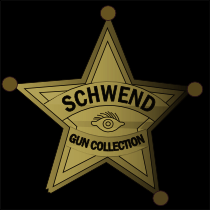
Below are a few of the 100 weapons
that survived the Wax Museum fire of 1988.
The
brass tags that appear attached to some of the pieces are the museum tags, which
were used for inventory purposes.
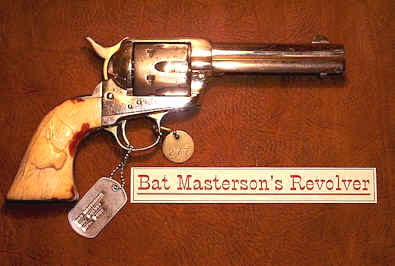 |
Bat Masterson's Colt
.45 Revolver Colt Single Action Revolver, .45 Caliber LC, Longhorn Grips, Gold Plated, Manufactured 1899 This gun was a museum favorite and was featured in nearly all of its promotional materials. It was a gift to Harrison Schwend from Bat Masterson who had retired from his life as a lawman, gambler and gunslinger. Masterson had heard, through mutual friends, of Schwend's passion for collecting weapons and, since he was a fellow lawman, the gift was particularly appropriate. Oddly enough, the gun Schwend carried for his 35 years as a peace officer was remarkably similar right down to the longhorn head grips. The Masterson gun, however, was gold washed while Schwend's was nickel plated and engraved. Traces of the gold finish are still visible. Harrison Schwend's gun has never been found, but the Masterson gun is a beautiful, original example of Colt's manufacturing genius. The longhorn grips are original to the gun and were the favored style of Masterson. 
 Bat Masterson at age 30 in 1880 (left) and later in life circa 1920 in his mid-60's (right) |
|
Frank Jackson's Colt
.45 Revolver Colt Single Action Revolver, .45 Caliber Centerfire, Manufactured 1877, Pearl Grips Frank Jackson was a loyal member of the Sam Bass Gang that specialized in robbing stages and trains. In July of 1878, the gang decided to rob the bank in Round Rock, Texas. Jim Murphy, one of the gang members, had secretly made a deal with the Texas Rangers to trap Sam and the gang in return for immunity from prosecution for his crimes. The Rangers were waiting in Round Rock when they arrived. In the ensuing gun battle, Seaborne Barnes was killed and Sam was mortally wounded, Jackson, who had not been hit, dismounted his horse amid a hail of bullets, and rescued Sam. When they reached safety, Sam was too faint to continue as he was near death. He told Frank to leave him and save himself. Frank Jackson rode away and was never seen or heard from again. This gun was dropped during that gun battle in Round Rock. The pearl grips are original to the gun. |
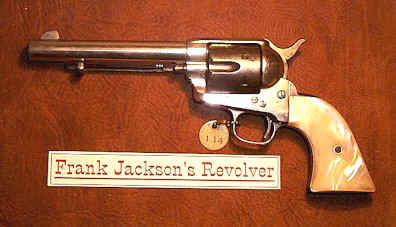 |
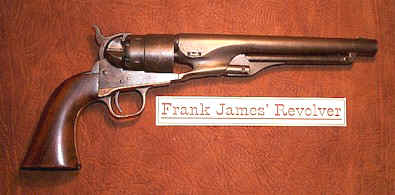 |
Frank James' Colt
.44 Revolver Colt Model 1860 Army Percussion Revolver, .44 Caliber, Manufactured 1869. Records indicate that this gun was dropped by Frank James in a brush with the law in Missouri in the early 1880's. The lawman who recovered it gave it to Harrison Schwend soon after as it was one of the first guns in the collection. Later in life Frank James would meet Deputy Schwend again during a brief stay in Henrietta while James was touring with Cole Younger in their own version of the Wild West Show. At that time Frank presented Schwend with brother Jesse's holster and coin purse. The holster was destroyed in the fire but the coin purse's metal parts survived and are part of the collection (see Photo Page Four). The grips have been replaced due to fire damage. 
 Jesse & Frank James (left) & Frank James later in life (right) |
|
Buffalo Bill Cody's Colt
.44 Revolver Colt Model 1860 Army Percussion Revolver, .44 Caliber, Manufactured 1863 This gun has an amazing history and was prominently featured in the Museum's brochures and promotional materials. Family records confirm that this is the gun that Buffalo Bill Cody, at the time a scout under Lieut. George M. Taylor in the service of General Carr, used to kill Chief Yellow Hand (also called Yellow Hair) in a bizarre confrontation. It occurred on July 17, 1876 just after the Custer Massacre within 8 miles of the Little Big Horn. Cody and his unit were out on patrol when they came upon a Cheyenne war party who were headed toward a rendezvous with Sitting Bull. Through field glasses, the detachment noticed that they were trailing and preparing to ambush a pair of army messengers who were delivering dispatches to the command. Cody and his group of 15 soldiers charged the Indians to intercept them before they attacked. When the two groups were within earshot, the chief yelled out to Cody, whom he recognized, to challenge him to a fight. Witnesses to the incident describe how Cody and Yellow Hand suddenly charged from each group. When they were 30 yards apart, Cody pulled his rifle and shot, killing the Chief's horse, while Cody's horse tripped in a prairie dog hole sending both men crashing to the ground. They rose with pistols not more than 20 paces apart, Cody pulled this 1860 Army pistol and in his own words, "we fired at each other simultaneously. My usual luck did not desert me on this occasion for his bullet missed me, while mine struck him in the breast", killing him. Unbelievably, Cody then pulled a knife from his sheath and scalped Yellow Hand raising it above his head and proclaiming it "the first scalp for Custer". Cody would later send the scalp home to his wife who was not at all thrilled to open it after the 4 weeks it took to get to her by overland stage. |
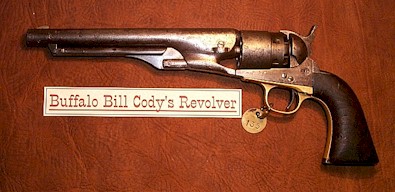 The Gun that Killed Chief Yellow Hand! "The First Scalp for Custer!" |
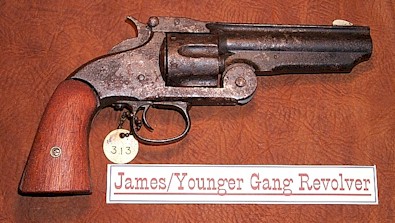 |
James/Younger Gang
.44 Revolver Smith & Wesson, Single Action, Model 3 Revolver, .44 Caliber The James/Younger Gang consisted of Frank and Jesse James, the Younger Brothers (Cole, Jim and Bob) and a host of other characters who participated in bank, train, and stage robberies in the decade following the Civil War. Most of these men had been members of Quantrill's Guerillas who fought for the South during the Civil War and continued their own little war against the Yanks after it had ended. This revolver belonged to a member of the gang, possibly Jesse James as this was his preferred model. Deputy U.S. Marshal White found it after a fight with the gang in Indian Territory in the late 1870's. The gun sustained heavy damage in the fire and has replacement grips of mahogany that comes close to the color of the original grips which can be seen in pre-fire photos. |
|
Cole Younger's Colt
.44 Conversions Colt Revolver Model 1860 Army, Richards Conversion, .44 Caliber Centerfire, Converted in mid 1870's Cole Younger was a member of the James Gang along with his brothers Jim and Bob. They robbed banks, stages, trains, anything that might contain valuables. Finally on September 7, 1876, the gang attempted to rob the First National Bank of Northfield, Minnesota. The townspeople were prepared and opened fire on the gang as they emerged from the bank. In the ensuing chase that lasted more than 3 weeks, two of the gang were killed, Cole was shot 11 times and all the Younger boys were captured. Frank and Jesse James were the only ones to escape. Cole spent the next 25 years in jail, was reformed and finally died on March 21, 1916. There are replacement grips on both guns as the originals were burned off in the wax museum fire. It is surmised that following Cole's release from prison, he gave the old Colts to collector Schwend during one of his many trips to Wichita Falls for the Quantrill Reunions which were held there. The upper Colt has had it's barrel cut while the lower is at the original length. With the serial numbers so close, these two guns were probably purchased at the same time from the same dealer.  Cole Younger following the abortive Northfield Minnesota Raid in 1876 at age 32 |
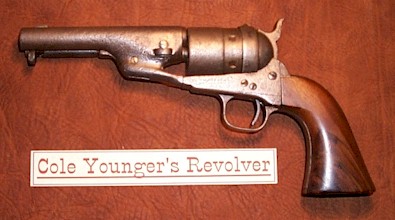 Serial Number 5093, Manufactured in 1861 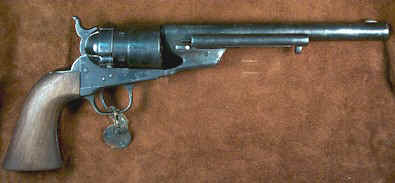 Serial Number 5090, Manufactured in 1861 |
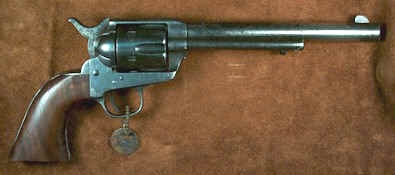 Captain McDonald's Colt .45 |
Captain
Bill McDonald's Colt .45 Colt Single Action .45 Caliber Revolver with 7.5" Barrel, Manufactured in 1882 William F. McDonald was Captain of Texas Rangers Company B, Frontier Battalion. Company B trailed outlaws and renegade Indians along the Texas frontier and into Indian Territory (Oklahoma) in the 1880's and 90's. This was Captain Bill's Colt 45 that he used throughout his career as a peace officer. It assisted him in many of his arrests and was used in numerous shootouts, many of which have been written about and published over the past 100 years. It was manufactured in 1882. McDonald himself gave the gun as a personal gift to Harrison Schwend sometime after the turn of the century. The grips are replacements as the originals burned in the museum fire of 1988. 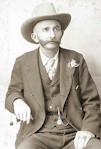 Captain Bill McDonald |
|
Bill Doolin's
Smith & Wesson .44 Smith & Wesson Model #3, Single Action, Second Issue Revolver, .44 Caliber S&W, Nimschke Engraved, Ivory Grips, Manufactured in 1873 William "Bill" Doolin was the leader of a gang of outlaws known as the "Oklahombres". He was associated with the Dalton Gang and, only by a twist of fate, was not present when the gang attempted to rob two banks at once in Coffeyville, Kansas in 1892 leaving four gang members dead. Doolin's turn came later when he was ambushed and killed by a posse in 1896 headed by Texas Ranger Heck Thomas. Doolin carried this giant hogleg for maximum firepower. It was big and it was flashy, just like Doolin's ego. It appears in family photos and various newspaper articles and was a very popular museum piece. It is surmised that it came into the collection as a result of Harrison Schwend's connection to officers engaged in encounters with Doolin in Oklahoma. According to the Factory Letter, this gun was manufactured and shipped in 1873 to M.W. Robinson, Market Street in New York City. This was S&W's largest distributor in NYC. 
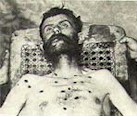 Bill Doolin in Life and Death |
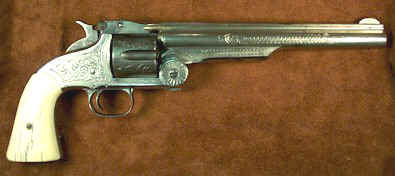 Bill Doolin's Smith & Wesson .44 |
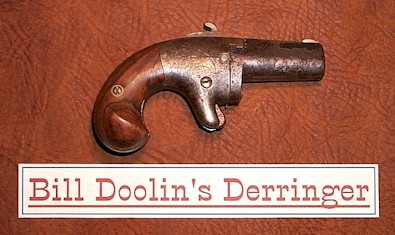 |
Bill Doolin's Derringer National Arms Company (Later Colt) Model #2 Single Shot Derringer, .41 Caliber RF with rare 2" Barrel Here is outlaw Bill Doolin's backup firepower. Doolin carried this little pistol in his boot, just in case he needed an extra shot. The grips are replacements. |
|
Texas Ranger
J. M. Britton's "Frontier Army" Colt Revolver Colt Single Action Revolver, .45 Caliber LC, U.S. Cavalry Model, 7.5 " Barrel, Manufactured 1874 This gun was carried by Texas Ranger Sgt. J. M. Britton who was a member of Company B, Frontier Battalion and served under Ranger Captain Bill McDonald in the 1890's. Company B trailed outlaws and renegade Indians along the Texas frontier and into Indian Territory (Oklahoma). This gun may have been captured and used by Sgt. Britton as a result of one of his many arrests as this Cavalry Model Colt was reportedly part of group of guns stolen from Fort Davis, Texas in the late 1870's. It is believed that this gun and the one below were given to Harrison Schwend through Captain McDonald who was Britton's superior in Company B. |
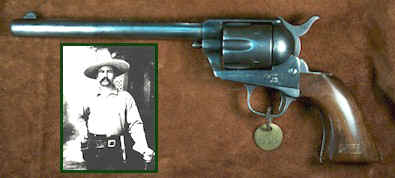 |
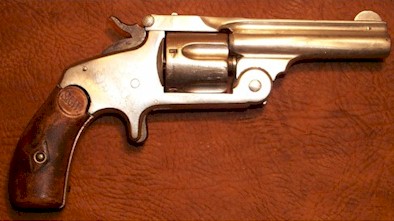 |
Texas Ranger
J. M. Britton's Smith & Wesson Revolver Smith & Wesson Second Model 1871 Single Action Revolver, .38 Caliber, Spur Trigger, 5 Shot, Total Production 108,255 This is another gun carried by Texas Ranger Sgt. J. M. Britton who was a member of Company B, Frontier Battalion and served under Ranger Captain Bill McDonald in the 1890's. Guns such as this were very popular among Rangers as "Back Up" weapons tucked away in a boot or in the trousers in that special instance where getting off another shot was critical. Very often, this hidden weapon was a life saver in difficult situations. Its small size made concealment easier and the single action, spur trigger action was safer to store in your clothing than a double action heavier model. |
|
Remington Single Action
.44 Revolver This is a very rare early Remington Model 1888, .44 Caliber WCF that has only recently been identified as the "Transitional" model. You will notice that this early design has a much shorter web under the barrel as opposed to the long sweeping one that characterizes most other Remingtons of this era. The original owner of this piece is still being investigated. This gun is all original. |
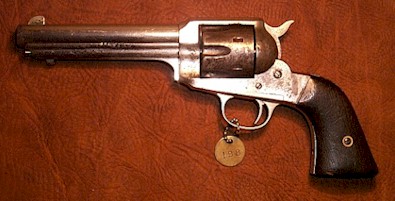 |
IF YOU HAVE ANY INFORMATION
ON THE WHEREABOUTS OF GUNS, PIECES OR PARTS FROM THE GRAND PRAIRIE WAX MUSEUM
FIRE OF 1988, PLEASE EMAIL: schwendguns@gmail.com.
MAYBE YOU'VE SEEN A TAGGED GUN AT A SHOW OR KNOW SOMEONE WHO HAS A SURVIVING
PIECE. I AM ACTIVELY SEEKING AND WILL PURCHASE COLLECTION PIECES.
THANK YOU!
HOME ABOUT GALLERY 2 GALLERY 3 GALLERY 4 BOOK CONTACT